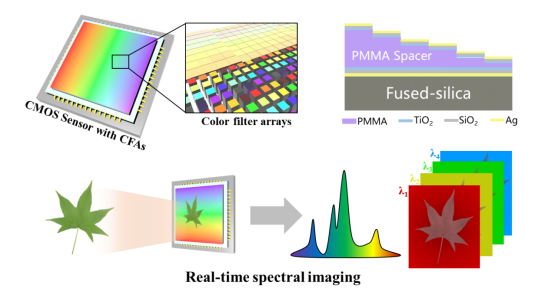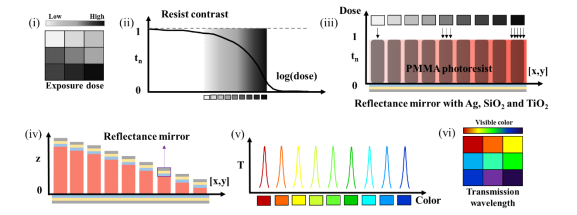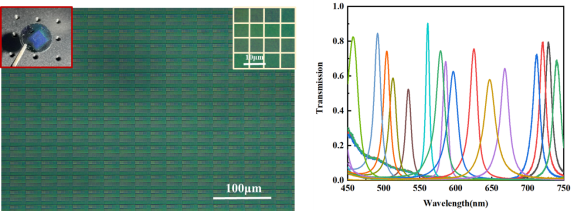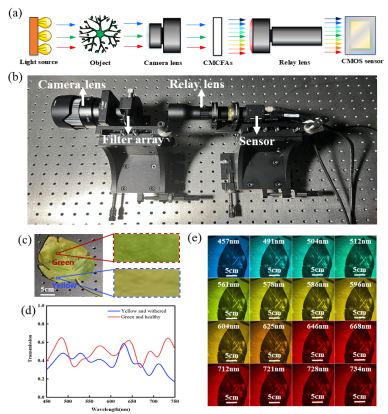Recently, team of Professor Zhanshan Wang and Professor Xinbin Cheng from IPOE implemented a multi-channel high spectral resolution integrated on-chip filter in the extended visible bandwidth with Grayscale-patterned EBL. The results were published in Optics Express with the title "Grayscale-patterned integrated multilayer-metal-dielectric microcavities for on-chip multi/hyperspectral imaging in the extended visible bandwidth ".

From classical RGB Bayer filters to multi/hyperspectral integrated color filter arrays (CFAs), on-chip spectral sensors have been a key characterization technology for spectral imaging in remote sensing. They allow the miniaturization of bulky spectrometers into compact and portable equipment. Among these micro/nano filters, FP microcavities have the most mature mechanism and the simplest tuning method, i.e., by varying their cavity length. Although they have been used commercial products, FP-cavity spectral sensors have suffered from a trade-off between a high spectral resolution and a wide working bandwidth, which limits designs using current configurations.
Complex, high-cost fabrication methods are another limitation on the number of spectral channels. Conventionally, FP-based CFAs with different cavity lengths require separate lithography processes assisted with combinatorial deposition/etching method. Typically, running N times of processes can achieve 2N integrated filter arrays, which is cumbersome, expensive, and inflexible. A potential solution has been proposed to utilize one-step grayscale lithography to flexibly control and customize the cavity length, which is a cost-effective, versatile, and wafer-scale framework. In the visible range, the unit size of a CMOS pixel is typically on the order of (or less than) one micrometer, which requires high-precision electron-beam lithography (EBL) fabrication. Therefore, the issue of on-chip spectral imaging with excellent spectral resolution and multi-channel in a wide spectral bandwidth remains a great challenge from the perspective of CFAs.

Figure 1. Schematic diagram of the grayscale lithography process
In this work, the team propose a novel configuration of FP-based CFAs consisting of multilayer metal-dielectric-mirror FP microcavities, which enables snapshot spectral imaging with a favorable spectral resolution of ∼10 nm over an extended visible band from 450 nm to 750 nm. An appropriate FP-microcavities array, composed of the multilayer mirrors (silver Ag/silicon dioxide SiO2/titanium dioxide TiO2) and a PMMA resist spacer layer, was designed. The exact operation that we can realize depends on – By adding another two dielectric layers on the metallic film, the broadband reflectance of the metal mirror was greatly enhanced along with an expected as-flat-as-possible reflection-phase dispersion. Moreover, we performed a fast and CMOS-compatible manufacturing process by using grayscale EBL lithography for multi-channel integration.

Figure 2. Color filter images, and spectral measurement results
The experimental results showed that the prepared 16-channel CFAs approached hyperspectral resolution (∼15 nm) over the whole bandwidth and easily supported snapshot spectral imaging, with high optical performance and identification capabilities.

Figure 3. Spectral system and imaging photos
The team characterized the compound material CFAs by the alternating optical system depicted. The results show a great improvement in the combined performance of resolution and bandwidth compared with the original metallic and all-dielectric FPs.
This work solved the bottleneck problem of insufficient bandwidth caused by reflectance dispersion by increasing metal reflectance with dielectric layer. The high-precision EBL 3D grayscale process has great potential to provide more spectral channels. In industrial production, grayscale masks with multi channels filters for stepper lithography can also be fabricated by EBL, thus improving the efficiency and stability of filter production.
Professor Xinbin Cheng (from Tongji University), and Siyu Dong (postdoctoral fellow from Tongji University) are co-corresponding authors of the paper. Jingyuan Zhu (postdoctoral fellow from Tongji University), Siliang Zhou (master candidate at Tongji University), and Yi Ning (doctoral candidate at Tongji University) are co-first authors of the paper. Collaborators with outstanding contributions to the paper also include Professor Zhanshan Wang (from Tongji University), and Xiong Dun (Distinguished Research Fellow).
Information of the paper:
Jingyuan Zhu, Siliang Zhou, Yi Ning, Xiong Dun, Siyu Dong, Zhanshan Wang, and Xinbin Cheng, "Grayscale-patterned integrated multilayer-metal-dielectric microcavities for on-chip multi/hyperspectral imaging in the extended visible bandwidth," Opt. Express 31, 14027-14036 (2023)
https://doi.org/10.1364/OE.485869
